Sportbike Bagger
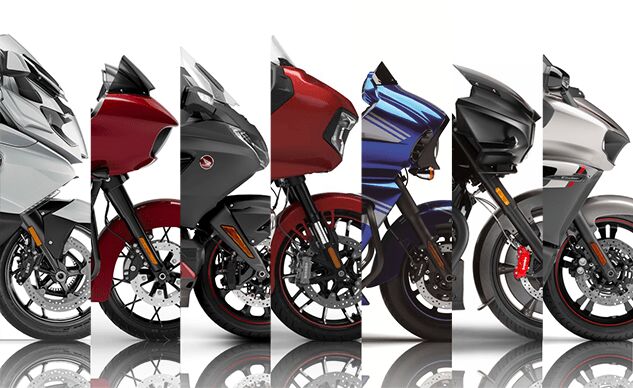
- Go Back
This all started with our recent Bagger Battle between the two juggernauts in the field: The Harley-Davidson Road Glide Special and the Indian Challenger Limited. In just nine days, that story garnered enough views on MO to make it our ninth-most read story of 2019 – and it was posted on December 23rd!
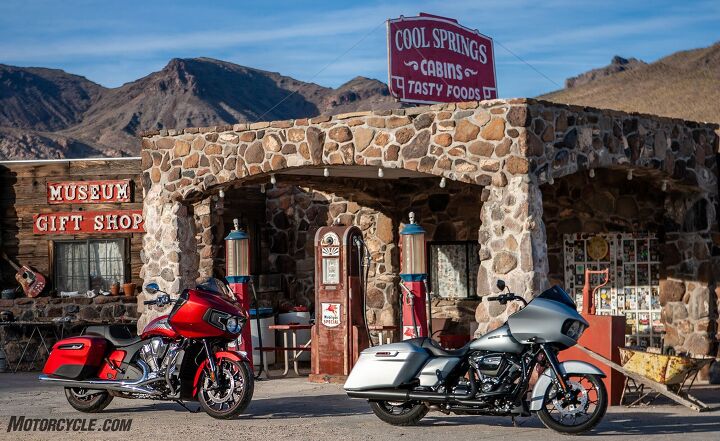
All that traffic got us thinking about how these two American giants stack up to the rest of the bagger field, although long-time MO readers might remember we've already done something similar – the Big Dam Tour shootout of 2018. Back then we actually rode all the bikes in the field, which consisted of:
- BMW K1600 B
- Indian Chieftain Dark Horse
- Kawasaki Vaquero
- Harley-Davidson Street Glide
- Harley-Davidson Road Glide
- Moto Guzzi MGX-21
- Yamaha Eluder
In lieu of the logistical nightmare that is putting seven motorcycles together for a test – especially since we've already ridden all of them – in this spec chart comparison we're going to swap the Indian and two Harleys for the Challenger Limited and updated Road Glide, respectively, and take a look at the numbers. All the other bikes in the field haven't changed much, if at all, since we rode them in 2018, which should give us a chance to see how far the new Harley and Indian have leapfrogged the field – or if they simply inch away.
Engines

Let's get right to the heart of the matter here. Engines define a motorcycle, and nowhere is this more true than in the cruiser category. Making this comparison interesting is the wide array of engine sizes in this match-up. Bringing up the rear of the field is the Moto Guzzi, with a "paltry" 1380cc – mounted transversely, no less! But what the MG lacks in displacement it makes up with a total of eight valves, four spark plugs, and a huge 104mm cylinder bore – second only to the Indian's 108mm cylinders. The result is 78.9 hp at 8000 rpm, more than the Kawasaki (68.7 hp) and Yamaha (75.2 hp). Of course, the tradeoff is a torque figure of 72.7 lb-ft at 2400 rpm. Last in this group by a wide margin.
From there the other V-Twins bump up in displacement quite a bit, starting with the 1700cc Kawasaki Vaquero, 1769cc Indian, 1854cc Yamaha, up to the 1868cc Harley Davidson. What's impressive here is how much horsepower the Indian punches – 95.0 hp at 5,000 rpm – despite its small-ish engine. [We should note here that the Challenger MO dynoed had significantly lower numbers and didn't rev as high as those in other magazine's tests. Indian tells us our tester was a "preproduction" unit, whose ECU cut the spark at 5000 rpm. The PowerPlus engine is supposed to make max horsepower at 5500 rpm (122 crankshaft hp), and redline at 6500. – Ed.] Liquid-cooling definitely helps, as does its single overhead cam (instead of power-robbing pushrods), eight valves, and aforementioned 108mm pistons. Also huge in this category is its sportbike-like 11.0:1 compression ratio. On the torque front, its 111.9 lb-ft at 3,300 rpm is the most in this group, including the six-cylinders!
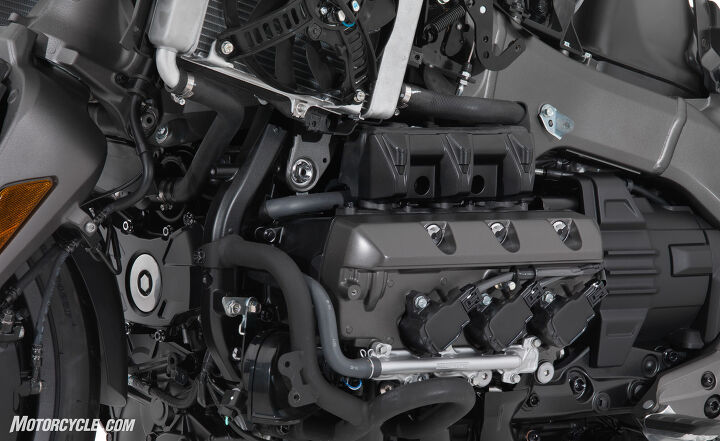
Ah, yes. The duo of six-cylinders. Both BMW and Honda come into this segment with the K1600B and Gold Wing, respectively, boasting not one, but six pistons going up and down. The BMW is the smaller of the two, at 1649cc, with the Honda coming in at 1833cc. If you've been paying close attention, the Harley Road Glide, while down four cylinders, trumps both of the metric machines in displacement. No matter, as both the BMW and Honda trounce all the others in the field with measured horsepower numbers of 131.8 and 102.1, respectively. Torque numbers are close, with the K1600B pulling 106 lb-ft and the Honda at 106.4 lb-ft.
Of course, the riding dynamics of a V-Twin versus a six-cylinder are vastly different, as explained in the Big Dam Tour story above. While the V-Twins deliver a rumbling pulse, the BMW and Honda give you silky smooth refinement. Hammer on the throttle, though, and the torque will quickly whisk you away, no matter what you're on.
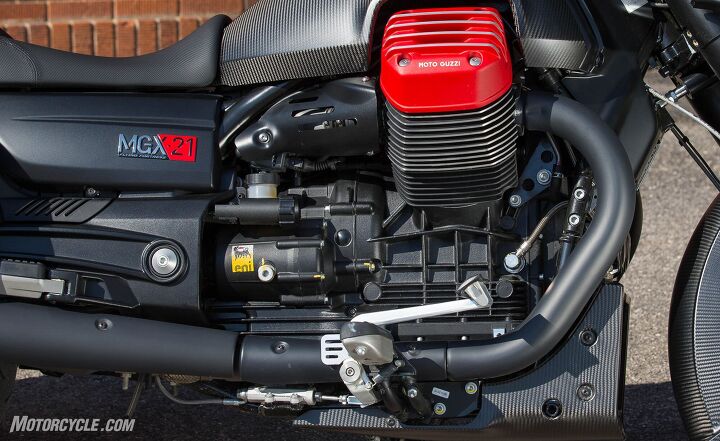
Considering the Bagger Battle and Big Dam Tour stories reveal all there is to know about the respective machines, the real question is how the new Road Glide and Challenger stack up against the old guard in the bagger category. Judging by the numbers, both bikes more than hold their own (except against the six-bangers). Especially the Indian. It seems remarkable what the Challenger can pull off despite its displacement deficit. The scorecard ratings reflect this, too. Despite being scored during separate tests, both the Harley and Indian engines tied in the ratings at 87.5%, far surpassing the 79.8% the highest-ranking BMW scored in the Big Dam test.
Suspension/Ride

Honda Gold Wing's front suspension
When it comes to suspension and ride quality, there are no big revelations the Harley or Indian bring to the table. The Harley rides on a 49mm fork with twin shocks in the rear while Indian went for inverted forks 43mm in diameter and just a single shock out back. The others similarly follow suit with telescopic forks and shocks. Once again, the BMW and Honda stand out – BMW for its Duolever front suspension and the Gold Wing for its double wishbone front end. For a bagger's intended purpose, shredding miles in comfort, it could be argued either method of quelling road imperfections is better than your standard fork/shock combo.
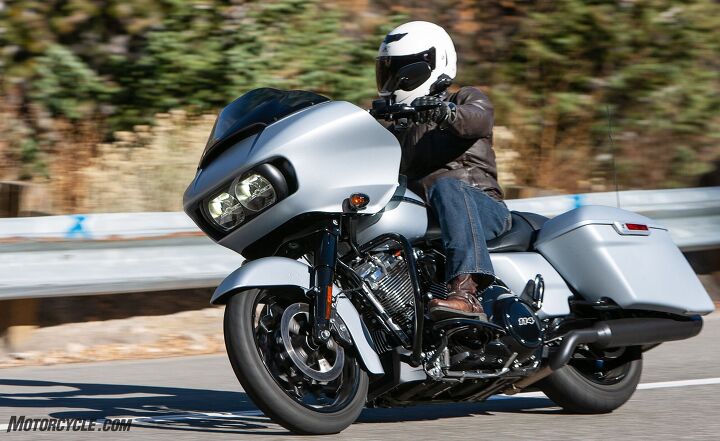
In the real world, the V-Twins still perform well. As Evans explains: "While you can tell the difference between the non-traditional front ends and the old, reliable telescopic fork (of both the standard or inverted variety), the front suspensions of all the bikes are more than capable of handling the rigors of travel – both on the interstate and two-lane highway. However, what truly differentiates the suspensions of these bikes is the shocks. The quality of these baggers' ride breaks down pretty much where you'd expect it to once you look at the specs for the rear suspension travel. The Harley ranks dead last, and with 2.1 inches of travel, it should come as no surprise. With the rest of the baggers having 50%-100+% more rear suspension travel, the results pretty much sort themselves out by the length of the stroke that the shock(s) have to deal with road conditions. Not surprisingly, the BMW and the Honda, with their transcontinental touring bike roots, smooth the hard knocks the best."
Fuel Capacity

Baggers are meant to shred miles, right? To do that you need a lot of gas in the tank. Looking down the line, we see the BMW leading the way with its massive 7-gallon tank. The Yamaha's 6.6-gallon capacity is a close second, with the new Road Glide and Challenger tied at 6 gallons. Ever since it was introduced, Honda was criticized for equipping the new Gold Wing with only 5.5 gallons (Honda says the new Wing is more efficient than the last, cancelling out the slight drop in capacity from before), but this is still more than the Moto Guzzi (5.4 gallons) and the Kawasaki (5.3 gallons). In our testing, which typically features heavy right hands, here's what kind of real-world mileage we've seen from each bagger:
| Motorcycle | Fuel Mileage (mpg) |
| BMW K1600B | 38 |
| Harley-Davidson Road Glide Special | 42 |
| Honda Gold Wing | 41 |
| Indian Challenger | 40 |
| Kawasaki Vulcan 1700 Vaquero | 38 |
| Moto Guzzi MGX-21 | 33 |
| Yamaha Star Eluder | 40 |
As you can see, despite the Honda's 5.5 gallons, the Wing's increased efficiency is more than just marketing fluff, scoring the second-best fuel mileage in the group. Only the new Road Glide bests it, and only by one solitary mile. With a result that close, they're basically nill. Despite its heft, the Yamaha's still able to nab 40 mpgs. Impressive. Way in the rear of the pack is the Guzzi, maybe because you need to wring its neck and keep the revs up to stay with the group and have fun. Of course, more revs means more gas.
Weight
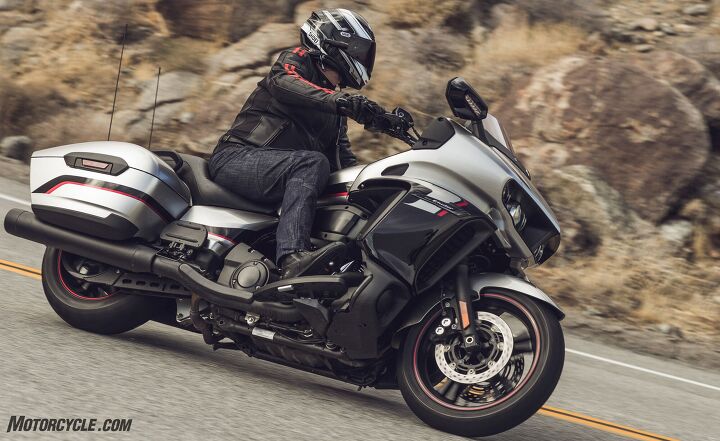
When it comes to heft, "only" 106 pounds seperates the lightest bike here, the BMW, from the Yamaha at the other end of the weight spectrum. It's slightly more remarkable considering the K16 has three times the number of cylinders as the Eluder. But the K16 also utilizes lighter plastic compared to the gobs of metal on the Yamaha. After the BMW comes the Guzzi (795 lbs), then the Honda. The Road Glide (847 lbs) and Challenger (835 lbs) are among the heavier bikes here, with the Kawi slotting in just behind the Harley at 845 lbs. Generally speaking, light makes right on a motorcycle, but if ever there was a category where poundage was a non-issue, it's this one. Who cares what it weighs; as long as it looks cool and stirs the soul.
Electronics

Isn't it funny how motorcycles were meant to be an escape from the imaginative, figurative, hopefully not literal, and now electronic chains of everyday life? Now all the rage is connecting your motorcycle to your devices so you can keep tabs on your electronic life via dashboard display. Like it or not, motorcycle electronics are continuing to evolve. Below are just some of the ways each individual motorcycle embraces the 21st century.
| Motorcycle | Electronics |
| BMW K1600B | Audio system with Satellite Radio and Bluetooth, Hill Start Control Pro, Gear Shift Assist Pro, Central Locking/Anti-Theft Alarm, Dynamic ESA, Ride Modes, Cruise Control, Multifunction Display, On-Board Computer, Auto-leveling Headlamp |
| Harley-Davidson Road Glide Special | Electronic cruise control, Boom! Box GTS audio system with GPS and 6.5" full color TFT touchscreen with Apple CarPlay, Bluetooth and voice recognition, USB connect and electric power accessory port, H-D Connect service, Reflex Electronic Linked Brakes with ABS. Optional Reflex Defensive Rider Systems (RDRS) including Cornering Enhanced ABS (C-ABS), Cornering Enhanced Traction Control System (C-TCS), Drag-Torque Slip Control (DSCS), Vehicle Hold Control (VHC), and Tire Pressure Monitoring System (TPMS). |
| Honda Gold Wing | Homelink (garage door opener), Apple Carplay, Tire Pressure Monitor, Cruise Control, Navigation |
| Indian Challenger | Lean-sensitive traction control and ABS, Cruise Control, Navigation (with traffic and weather overlays), Ride Planning and Tracking (via phone app), Glove-compatible 7-inch touchscreen, Bluetooth |
| Kawasaki Vulcan 1700 Vaquero | AM/FM/WB audio system with iPod and SiriusXM radio compatibility, Cruise Control, |
| Moto Guzzi MGX-21 | Ride Modes, ABS, Traction Control (3 level), Cruise Control, AM/FM Stereo, Bluetooth, MG-MP phone app, |
| Yamaha Star Eluder | 7-inch Color LCD Touchscreen, Bluetooth, GPS Navigation (optional), CB Radio (optional), Satellite weather and traffic (optional) |
Price

On the surface, all seven of these baggers seem to be on a fairly even playing field as far as base price goes, with the Kawasaki's $16,799 being the least expensive and the DCT version of the Honda Gold Wing bringing up the other end of the price scale. But let's not fool ourselves into thinking anyone would buy a base version of any of these. Depending how wild you want to go, with the exception of the Moto Guzzi and Kawasaki, each of these models can be accessorized to the moon from the factory, and the resulting price tag can knock on the door of 40-large. And that doesn't include accessories you can find in the aftermarket…
| Motorcycle | Base Price |
| BMW K1600B | $20,095 |
| Harley-Davidson Road Glide | $21,699 |
| Honda Gold Wing | $23,800 (6-speed), $25,000 (DCT) |
| Indian Challenger | $21,999 |
| Kawasaki Vulcan 1700 Vaquero | $16,799 |
| Moto Guzzi MGX-21 | $21,990 |
| Yamaha Star Eluder | $22,499 – $23,999 |
What Have We Learned Here?
If ever the saying "Different strokes for different folks" applies, it certainly does here. Seven different interpretations of a bagger – some traditional, others not – all excelling in their own ways. However, the point of this spec chart comparison was to see how the new Harley Road Glide and Indian Challenger slotted in with the pack. It shouldn't have been much of a surprise, but the two are standouts in this category. Their combination of style, power, refinement and technology continue to be the benchmark others rate themselves against. But what do you think? Are the Road Glide and Challenger top dogs, or have we completely missed the boat (again)? Let us know below.
Specifications
-
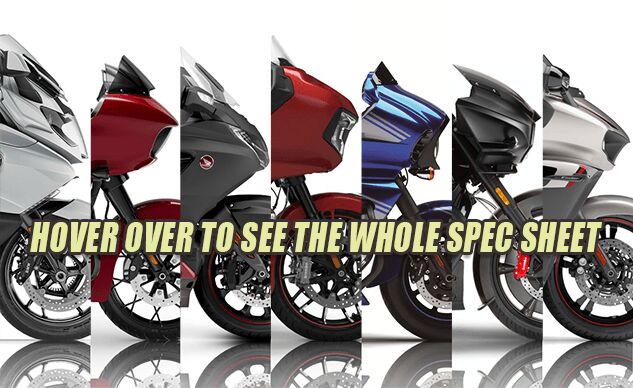
2020 Baggers Spec Chart Comparison Specifications 2019 BMW K1600B 2019 Harley-Davidson Road Glide Special 2020 Honda Gold Wing 2019 Indian Challenger 2019 Kawasaki Vulcan 1700 Vaquero ABS 2019 Moto Guzzi MGX-21 Flying Fortress 2018 Yamaha Star Eluder MSRP $20,095 base 21,699 base $23,800 (6-speed) / $25,000 (DCT) $21,999 base $16,799 base 21990 $22,499-$23,999 Engine Type Liquid cooled, inline 6-cylinder, four valves per cylinder, double overhead camshafts, dry sump lubrication Twin-cooled, Milwaukee-Eight 114 45° V-Twin Horizontally opposed six-cylinder, four valves per cylinder, single overhead Unicam, finger-follower rocker arm on intake, roller-rocker arm on exhaust Liquid-Cooled SOHC 60° V-Twin; 4 valves/cylinder, 108 cu in 52° V-twin, liquid-cooled Air and oil-cooled 90° V-Twin, 4-valve, dual spark ignition per cylinder Air-cooled OHV V-twin; 8 valves Displacement 1649cc 1868cc 1833cc 1769cc 1700cc 1380cc 1854cc Bore x stroke 72.0 mm x 67.5 mm 102.0 mm x 114.3 mm 73.0 mm x 73.0 mm 108.0 mm x 96.5 mm 102.0 mm x 104.0 mm 104.0 mm x 81.2 mm 100.0 mm x 118.0 mm Fuel Delivery Electronic fuel injection with ride-by-wire throttle system Electronic Sequential Port Fuel Injection (ESPFI) EFI, 50mm throttle body Electronic fuel injection, closed loop/52 mm dual bore DFI 42mm throttle bodies Phased electronic Multipoint sequential injection, Magneti Marelli IAW7SM, "ride by wire", 52 mm throttle body, IWP 243 Magneti Marelli injectors, double oxygen sensor, integrated management of 3 engine mappings, traction control, cruise control Yamaha Fuel Injection with YCC-T and D-Mode Compression ratio 12.2:1 10.0:1 10.5:1 11.0 : 1 9.5:1 10.5 : 1 9.5:1 Peak hp, Dynojet 250 rear wheel 131.8 hp @ 8000 rpm 80.0 hp @ 4700 rpm 102.1 hp at 5500 rpm (measured) 95.0 hp @ 5000 rpm 68.7 hp @ 5300 rpm 78.9 hp @ 6600 rpm 75.2 hp @ 4300 rpm Peak Torque 106.0 @ 5200 rpm 106.8 lb-ft @ 2900 rpm 106.4 lb-ft. at 4200 rpm (measured) 111.9 lb-ft @ 3300 rpm 87.9 ft-lb @ 3200 rpm 72.7 lb-ft @ 2400 rpm 105.8 lb-ft @2800 rpm Transmission Constant-mesh 6-speed gearbox with helical cut gears, multi-plate wet clutch, hydraulically operated 6-speed 6-speed manual or
7-speed automatic DCT w/ Walking Mode F/R6-speed; wet, multi-plate 6-speed with overdrive and positive neutral finder 6-speed, dry single plate clutch with flexible couplings 6-speed; multiplate assist and slipper wet clutch Final Drive Shaft drive Belt Shaft Belt Carbon fiber-reinforced belt Double cardan joint and fixed bevel gear seat Belt Front suspension BMW Motorrad Duolever; central spring strut, 4.5 inches travel 49mm conventional fork Double-wishbone front-suspension system w/ Showa shock absorber, 4.3 in. travel Inverted telescopic fork, 43 mm diameter, 5.1 in (130 mm) travel 45mm hydraulic fork, 5.5 inches travel Standard fork , 46 mm 46mm telescopic fork; 5.1-in travel Rear suspension BMW Motorrad Paralever, 4.9 inches travel Dual emulsion-style shocks, hydraulically adjustable preload on left shock Pro-Link system w/ Showa shock absorber, 4.1 in. travel Single shock 4.5 in (114 mm) travel, hydraulic adjustable Swingarm with twin air-assisted shocks, with 4-way rebound damping, 3.1 inches travel Double shock absorber with adjustable rebound and remote spring preload Single shock with remote preload adjustment; 4.3-in travel Front Brake Dual floating disc brakes, 4-piston fixed calipers, diameter 320 mm, ABS Dual 320mm, four-piston calipers Two radially mounted 6-piston Nissin calipers w/ 320mm rotors, electronically controlled combined ABS Dual 320 mm floating rotors with 4-piston calipers, ABS Dual 300mm discs, dual four-piston calipers, K-ACT II ABS Dual 320 mm stainless steel floating discs, Brembo radial callipers with 4 horizontally opposed pistons: ABS as standard equipment Dual hydraulic disc, 298mm; Unified Brake System and ABS Rear Brake Single disc brake, diameter 320mm, dual-piston caliper, ABS 320mm, four-piston caliper 3-piston Nissin caliper w/ 316mm rotor, electronically controlled combined ABS Single 298 mm floating rotor with 2-piston caliper, ABS Single 300mm disc, twin-piston caliper, K-ACT II ABS 282mm stainless steel discs, Brembo floating caliper with 2 pistons: ABS as standard Hydraulic disc, 320mm; Unified Brake System and ABS Front Tire 120/70 ZR 17 BW 130/80B17 65H 130/70-18 Metzeler Cruisetec, 130/60B19 66H 130/90×16 120/70-R21 62V 130/70R18 Bridgestone Exedra Rear Tire 190/55 ZR 17 BW 180/65B16 81H 200/55-R16 Metzeler Cruisetec, 180/60R16 80H 170/70×16 180/60-R16 80H 200/55R16 Bridgestone Exedra Rake/Trail ??/4.2 inches 26°/6.7 in. 30.5°/4.3 in. 25°/5.9 in. 30°/7.0 in 27.8°/4.9 inches 31.0°/5.7 inches Wheelbase 63.7 inches 64.0 inches 66.7 in 65.7 in. 65.6 in 66.7 in. 67.6 inches Measured Weight 768 lb 847 lb 806 lbs (DCT, measured) 835 pounds 845 lb 795 lb 874 lb Storage Capacity 19.5 gal. 16.9 gal. total 7.9 gal. >18 gal. 19.2 gal. 15.2 gal. 18.8 gal. Seat height Standard: 30.7 in., Low Seat: 29.5 in. 29.0 in. 29.3 in. 26.5 in. 28.7 in 29.1 in. (28.3 in. option) 27.4 in. Fuel Capacity 7.0 gal. 6 gal 5.5 gal. 6 gal. 5.3 gal 5.4 gal. 6.6 gal. Fuel Economy 38 mpg 42 mpg 41 mpg 40 mpg 38 mpg 33 mpg 40 mpg Available Colors Black Storm Metallic Vivid Black, River Rock Gray, Billiard Red, Barracuda Silver Denim, Scorched Orange/Silver Flux, Zephyr Blue/Black Sunglo Candy Ardent Red
Matte Majestic Silver
Pearl Stallion BrownTitanium Metallic, Thunder Black Smoke, Sandstone Smoke, White Smoke, Thunder Black Pearl, Deepwater Metallic, Ruby Metallic Metallic Spark Black Black Impact Blue, Raven, Liquid Silver
Source: https://www.motorcycle.com/shoot-outs/2020-baggers-spec-chart-comparison

0 komentar:
Posting Komentar